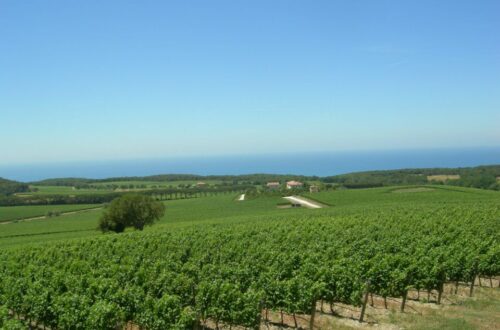Table of Contents
What is Gabiano DOC?
Gabiano DOC is one of Piedmont’s most historic and smallest wine appellations, producing elegant, structured reds from the Barbera grape. Nestled along the Po River in northwestern Italy, Gabiano’s wines are deeply tied to their noble heritage — anchored by the Castello di Gabiano, a medieval fortress that has presided over these vineyards for centuries. With production limited to a tiny pocket of Monferrato, Gabiano DOC is a true Italian rarity.
History and Origins
Winegrowing in Gabiano dates back at least to the 8th century, but the area’s vinous prestige flourished under the Marchesi Cattaneo Adorno Giustiniani, the noble family who have owned Castello di Gabiano for generations. In the 18th and 19th centuries, Gabiano was renowned for powerful, age-worthy Barbera-based wines, often reserved for aristocratic tables in Turin and beyond. The DOC was officially established in 1976, preserving its traditional blend and safeguarding one of Italy’s most distinctive micro-appellations.
Where It’s Made: Geography & Terroir
The Gabiano DOC covers only the communes of Gabiano and Moncestino, in the Monferrato Casalese area of Piedmont’s Alessandria province. The vineyards sit between 100–300 meters above sea level, perched on hills that slope toward the Po River. The terroir benefits from:
- Alluvial and calcareous clay soils – rich, well-draining soils that balance vigor and concentration.
- Po River influence – moderates extremes, creating a long, even ripening season.
- Piedmont’s continental climate – warm days and cool nights enhance aromatics and preserve acidity.
The Grape (or Blend)
Gabiano DOC wines must be at least 90% Barbera, with up to 10% combined Freisa and/or Grignolino allowed. Barbera brings deep color, brisk acidity, and juicy cherry-plum fruit, while the minor varieties add floral lift (Grignolino) or earthy spice (Freisa).
Winemaking & DOC Regulations
To carry the Gabiano DOC label, wines must meet these requirements:
- Grape composition: Min. 90% Barbera, max. 10% Freisa and/or Grignolino.
- Aging: Minimum 1 year before release; Gabiano Riserva requires at least 2 years, including 6 months in bottle.
- Alcohol: Minimum 12%.
- Style: Always red, still, and dry.
Producers often mature Gabiano in large oak casks or tonneaux to refine tannins and layer complexity without masking Barbera’s bright personality.
Key Facts at a Glance
- Region: Piedmont (Alessandria province, Monferrato Casalese)
- DOC Established: 1976
- Primary Grape: Barbera
- Total Area: Among the smallest DOCs in Italy
- Signature Producer: Castello di Gabiano
- Styles: Gabiano DOC, Gabiano DOC Riserva
- Notable Feature: Centuries-old castle estate overlooking the Po River
Tasting Notes
Appearance: Deep ruby with purple reflections.
Aromas: Black cherry, plum, violets, licorice, and subtle earthy spice.
Palate: Medium- to full-bodied, with vibrant acidity, silky tannins, and a lingering finish of red fruit and sweet herbs. Riserva bottlings show greater structure, leather, and savory depth.
Serving & Pairing
Serve Gabiano DOC at 16–18°C (60–64°F) in large Burgundy-style stems to open up the aromatics. Pair with:
- Piedmontese classics – agnolotti del plin, braised beef (brasato al Barbera)
- Hearty pasta dishes – tagliatelle with wild boar ragu
- Aged cheeses – Castelmagno, Parmigiano Reggiano
- Game meats – venison, duck, or hare
Where to Buy & Pricing
Gabiano DOC is a niche wine, with most production from Castello di Gabiano. Bottles are often available via specialty Italian wine importers, high-end wine shops, and online merchants. Expect to pay:
- Standard DOC: $20–$30 USD
- Riserva: $35–$50 USD
FAQ on Gabiano DOC
Q: How is Gabiano different from Barbera d’Asti?
A: Gabiano uses a similar grape but comes from a much smaller area, often with a touch of Freisa or Grignolino, giving a spicier, more structured profile.
Q: Is Gabiano DOC good for aging?
A: Yes — Riserva bottlings can age 8–12 years, developing truffle, leather, and balsamic notes.
Q: Can I visit the vineyards?
A: Absolutely. Castello di Gabiano offers tastings, estate tours, and even luxury accommodations.
Fun Facts & Cultural Notes
- Royal Heritage: Gabiano wines were historically served at the Savoy court in Turin.
- Castle Cellars: The vaulted cellars of Castello di Gabiano have stored wine for centuries.
- Wine Tourism Gem: Gabiano combines wine, history, and architecture in one of Piedmont’s most scenic corners.
CTA
Have you ever tasted Gabiano DOC? Share your experience in the comments or tag us on Instagram @DrinkItalian with your favorite Gabiano pairing.


